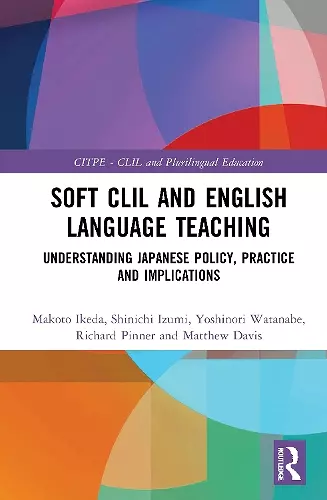Soft CLIL and English Language Teaching
Understanding Japanese Policy, Practice and Implications
Richard Pinner author Makoto Ikeda author Shinichi Izumi author Yoshinori Watanabe author Matthew Davis author
Format:Hardback
Publisher:Taylor & Francis Ltd
Published:25th Aug '21
Currently unavailable, and unfortunately no date known when it will be back
This hardback is available in another edition too:
- Paperback£39.99(9780367618315)

Content and Language Integrated Learning (CLIL) is a transformative and powerful approach to language education and has had a significant impact on educational pedagogy in recent years. Despite burgeoning literature on the efficacy and implementation of CLIL, there remains a gap between CLIL and English Language Teaching (ELT). Many practitioners wonder how they can ‘do CLIL’ if their main classes are focused on English as a Foreign Language (EFL). This volume addresses these concerns by examining the experiences of various CLIL practitioners in the EFL context of Japan.
Chapters outline the CLIL methodology, the differences in ‘hard CLIL’ (subject led) and ‘soft CLIL’ (language-oriented) before focusing on the EFL interpretations of soft-CLIL. Although the distinction of hard CLIL and soft CLIL has been mentioned in several publications, this is the first book-length exploration of this issue, featuring chapters examining expectations, challenges, material support, implementation, and even motivation in CLIL classrooms. All of this culminates in a review of the potential and future of CLIL in EFL contexts, paving the way for more widespread and well informed implementation of CLIL all over the world.
"This volume articulates how CLIL has become a tour de force for further developing English language teaching in the Japanese context. Relevant for educators worldwide, it describes key success drivers for applying CLIL across the educational spectrum. Authored by leading experts in the field, the easy-access chapters answer key questions that educators often have when considering if CLIL is possible to implement in their schools, and how to do it successfully. Insights on common strands between theory and practice, and descriptions of how CLIL models can be designed, make this publication a comprehensive and invaluable contribution to the field."
-David Marsh PhD, FRSA (Finland)
"At a time in CLIL research and pedagogy when it is key to take into account the specificities across contexts and types of CLIL, this excellent book is a unique contribution to the role of CLIL in EFL classrooms. It addresses relevant issues in soft CLIL such as translanguaging, focus on form, materials or assessment, providing a rich source of information for both researchers and educators."
-Ana Llinares, Universidad Autónoma de Madrid (Spain)
ISBN: 9780367145637
Dimensions: unknown
Weight: 440g
182 pages